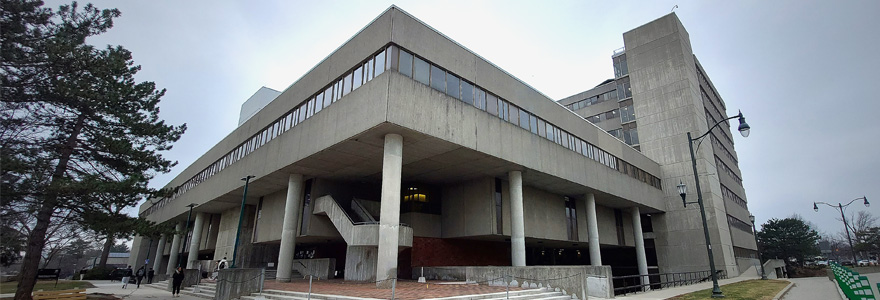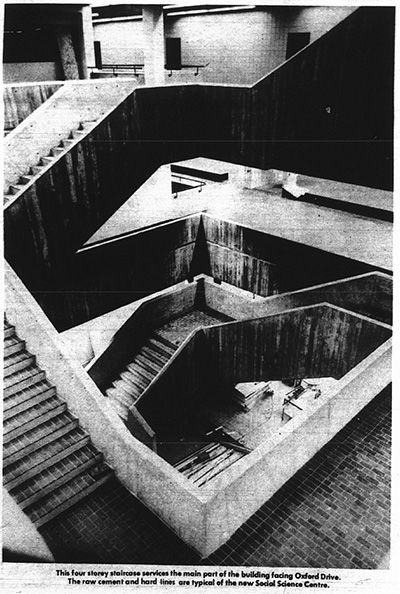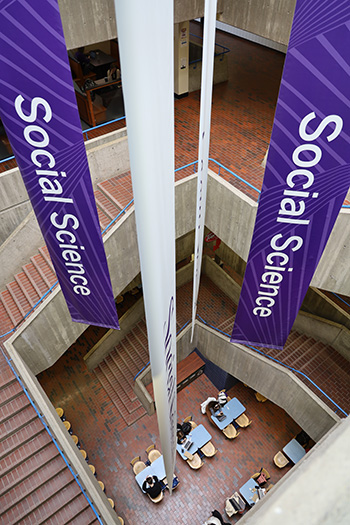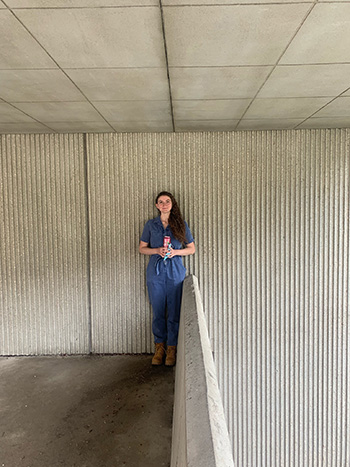News and Updates
Contact
Faculty of Social Science
Social Science Centre
Room 9438
Western University
T. 519-661-2053
F. 519-661-3868
E. social-science@uwo.ca
Celebrating the first 50 years of the Social Science Centre
April 03, 2023 
On March 21, 1973, the Social Science Centre officially opened its doors.
For the past 50 years, the building has been home to the largest faculty at Western. Courses taught by Social Science, and in the Social Science Centre, have provided strong foundations for successful careers and lives.
The Faculty of Social Science was created in 1968, made up of eight departments – Anthropology, Economics, Geography, History, Political Science, Psychology, Secretarial Science, and Sociology. The Social Science Centre was built to bring all those departments under one roof. Plans for the building actually began in 1965, initially as a building to bring together the Psychology department together in one building. This later expanded to include the newly formed faculty. Built at a cost of $11.5 million, the Social Science Centre became the biggest building on campus when it opened.
 The centre was designed by architect Norbert Schuller and built by Ellis-Don construction. The primary philosophy in the design and build seemed to be functionality and affordability. It was built on a modular system with a repetitive grid pattern, and with flexibility for alterations. The modular design was also intended to help with possible expansion in the future.
The centre was designed by architect Norbert Schuller and built by Ellis-Don construction. The primary philosophy in the design and build seemed to be functionality and affordability. It was built on a modular system with a repetitive grid pattern, and with flexibility for alterations. The modular design was also intended to help with possible expansion in the future.
With a post-war population boom, there was an increase in the number of universities across Canada. Many existing universities, Western included, underwent expansion projects. By the 1970s, the student population began to decline and there were concerns about an economic recession. Grant Reuber, Dean of Social Science at the time, noted that budget constraints led to some design decisions, including less focus on aesthetics.
Despite the intent to be a home for all the departments, when the SSC opened, three departments were already short of space. Planning for department space occurred 5 years before construction, and some departments grew faster than anticipated. The building was built to last, and Associate Dean Dave Chambers compared the SSC to iconic buildings at Oxford University.
Writing in Western’s First Century, historian J.R.W. Gwynne-Timothy noted that the Social Science Centre was among a series of buildings that provided Western with “a physical character likely to endure. Its impressive structures were the outward and visible signs of the immense enrichment of the amenities and facilities for the students at Western. They gave substance to the place of the university in the intellectual life of the country and indicated how far during its first century Western had come from the slender resources of its origin. On the Canadian scene Western had become a major university.”
The Brutalist Aesthetic

The Social Science Centre was the last of three brutalist buildings, constructed at the western edge of Western’s campus in the early-1970s – the. D.B. Weldon Library, and the University Community Centre being the others.
Brutalist architecture is a design style that emerged during the 1950s in the United Kingdom, among the reconstruction projects of the post-war era. Brutalist buildings are characterised by minimalist constructions that showcase bare building materials and structural elements over decorative design. The style commonly makes use of exposed, unpainted concrete or brick, angular geometric shapes and a predominantly monochrome colour palette.
With the building boom occuring across the academic sector in the 1960s and 70s, the brutalist style came to dominate campuses. Look around the Social Science Centre, and you can see the brutalist elements prominently. The cement walls, the soaring open space in the atrium, and the main staircase inside and outside of the building are all examples of the brutalist motif.
Brutalism is an architectural style and a philosophical approach to architectural design and construction, focused on creating simple and functional buildings that accommodate their purpose, inhabitants, and location.
Brutalist buildings are usually constructed with reoccurring modular elements representing specific functional zones, distinctly articulated and grouped together into a unified whole. When the SSC was opened, newspaper coverage noted the modular design, built with affordability and function in mind.
In an article in the Western News, chief architect Norbert Schuller noted that the building was not a “prima donna building”; “It is a structure which has evolved from the functions within. The bright interior colours were picked for their excitement and stimulation. The building ‘reflects everything of today – fast-moving, speed, economy, and practicality.”
Comings and Goings

In the 50 years since it opened, the Social Science Centre has witnessed many changes, both in terms of aesthetics and function.
The Social Science Centre was built to be home for all the departments that made up Social Science. Before the building was opened, for instance, the department of Psychology was housed in four different buildings. As our departments grew, they outgrew the Social Science Centre. While Psychology’s main office is still in the SSC, the department once again has four locations on campus!
One unique aspect of the SSC was an early education centre, which was located on the 5th floor. This centre served the dual purpose of providing child care options for faculty and staff, and research and training opportunities for psychology students. This centre initially moved to Westminster Hall, and the service is now no longer available.
Many of our departments have grown, and some have changed their name. The Department of Secretarial Sciences became the Department of Secretarial and Administrative Studies, then the Centre for Administrative and Information Studies. CAIS was amalgamated into the Administrative and Commercial Studies program, and then Management and Organizational Studies. It is now the DAN Department of Management & Organizational Studies, and is home to the largest number of undergraduate students in the faculty.
The Department of History moved to its home in Lawson Hall in 2011. Geography is now the Department of Geography & Environment, to better show the connections between people and their environment. When the building opened, the first floor was home to a Map Library; this has been moved to Weldon Library, and the original map library space is now the Social Science Reading Room, which opened in 2017.
Many new programs have been created and call the SSC home, including the Indigenous Studies program, the International Relations program, Politics, Philosophy and Economics, Transitional Justice and Post-Conflict Resolution and the Urban Development program.
Although the building was characterized by bare concrete and lack of adornment, there have been additions to add more colour and artistic expression throughout the building.
The Stained Glass Skylight in the atrium, a work by Christopher Wallis, was installed in 1986. A metal statue – a work called The Conquistador by artist Peter Hide – was installed in the outside seating area to the north of the building, in 1991. Numerous murals have been added to the walls, including two completed in the early 2000s by David Kanatawakhon-Maracle and other artists, and one designed by Mike Cywink, completed in 2023.
What does the Social Science Centre mean to you?
A building is just a space, and its true meaning is defined by the community within it. Over the past 50 years, countless students, faculty and staff have called the Social Science Centre their home at Western.
We asked our community members to share their stories about how they made the Social Science Centre home.
“When in high school we took a trip to the map library, it was the first time I set foot in the building, this would have been grade 10. Got to see the building and walk the halls. The red tile floor always stuck with me. It's sad that that library is gone now, but it's a great space for current students.”
- Maureen O'Connell, (Honours Specialization in History with a Major in Earth and Planetary Science, 2007)
 “As an alumna of Social Science in the late 90's, I remember there being a feeling of support for me as a student. I really enjoyed my time here and it provided a solid foundation for the rest of my academic journey as well as my career. I now work in the Faculty of Social Science and have felt like I was right back "at home" from the moment I stepped back into the building 17 years after graduating. It's an interesting shift to now support Social Science students knowing I once was one of them. A full-circle moment happened for me when I came back to the Social Science Centre as a staff member and I still have fond memories when I walk through the building. I walk by the alcove on the second floor every day and I think back to when I was a student and read textbooks there (and sometimes caught some shut eye) between classes. I was so comfortable in this building as a student and I feel a sense of belonging here now, as a staff member. I guess what sums up my feelings, past and present, about the Social Science Centre is that it brings me a sense of comfort and feels like hom
“As an alumna of Social Science in the late 90's, I remember there being a feeling of support for me as a student. I really enjoyed my time here and it provided a solid foundation for the rest of my academic journey as well as my career. I now work in the Faculty of Social Science and have felt like I was right back "at home" from the moment I stepped back into the building 17 years after graduating. It's an interesting shift to now support Social Science students knowing I once was one of them. A full-circle moment happened for me when I came back to the Social Science Centre as a staff member and I still have fond memories when I walk through the building. I walk by the alcove on the second floor every day and I think back to when I was a student and read textbooks there (and sometimes caught some shut eye) between classes. I was so comfortable in this building as a student and I feel a sense of belonging here now, as a staff member. I guess what sums up my feelings, past and present, about the Social Science Centre is that it brings me a sense of comfort and feels like hom
- Ann Seabrook (Honours BA Psych '99, BEd '00, MPEd '19)
“As a part time lecturer returning to Western more than 20 years later, I can tell you that the stairwells at the SSC, still smell the same and evoke feelings of studying, education and friendship."
- Jean Coles (ACS, 2001)
 I moved to London, ON in the middle of the Covid-19 pandemic to collect data for my master's degree research. I had done all of my coursework online and had only stepped foot in the Social Science building once before— on a tour that ended with me deciding to come to Western for grad school. When I stepped foot in the building (for the second time), it still felt familiar. I went into my lab space and was so excited to see everything; it was daunting to see all of the equipment that I would need to set up and calibrate, but I was so happy to finally be here. Walks down to the Lower UCC Starbucks became routine, sipping Mango Dragonfruit Refreshers in the sunken atrium beside the SSC-UCC tunnel a new favorite pastime. One day, when the weather was nice, I decided to walk outside instead of through the tunnel. In that moment, I became enamored with the idea of taking a picture in this one outside corner of the Social Science Centre. There was no reason for it. It was simply a moment of fun in an otherwise ordinary day. It might be silly, but I'm so happy to have that picture, if only to have proof of a moment where I gave in to joy. I am thankful to the SSC for providing me that opportunity, and now, as a PhD student in the same lab and in the same building, I look forward to all the simple moments to come.
I moved to London, ON in the middle of the Covid-19 pandemic to collect data for my master's degree research. I had done all of my coursework online and had only stepped foot in the Social Science building once before— on a tour that ended with me deciding to come to Western for grad school. When I stepped foot in the building (for the second time), it still felt familiar. I went into my lab space and was so excited to see everything; it was daunting to see all of the equipment that I would need to set up and calibrate, but I was so happy to finally be here. Walks down to the Lower UCC Starbucks became routine, sipping Mango Dragonfruit Refreshers in the sunken atrium beside the SSC-UCC tunnel a new favorite pastime. One day, when the weather was nice, I decided to walk outside instead of through the tunnel. In that moment, I became enamored with the idea of taking a picture in this one outside corner of the Social Science Centre. There was no reason for it. It was simply a moment of fun in an otherwise ordinary day. It might be silly, but I'm so happy to have that picture, if only to have proof of a moment where I gave in to joy. I am thankful to the SSC for providing me that opportunity, and now, as a PhD student in the same lab and in the same building, I look forward to all the simple moments to come.
- Madelyn Hertz (Anthropology - PhD – 2027)
"I was an undergraduate student in Social Science at Western when the ‘new’ building was opened. We had definitely been scattered between Talbot, Middlesex, and University College before the building opened, though not all the departments were all in one place from the start.
In those days the bus ran in front of the building, so the four floors at front were the most obvious. Entering the front doors, the building looked huge and confusing. It took a couple of wrong turns to find the nine floors at the back! It may have been a very modern building, but it actually had a Porter’s Lodge at the front door. Rather quaint in a poured concrete brutalist building. I wonder what the architect thought about that!
It is interesting to look at the building now and see how much more student-oriented it has become. More seating, a larger Counselling Office, a Study/Reading Room and an Internship Office are all much needed spaces. Even art! The building has evolved from basically a classroom building to a Social Science Centre.
- Linda Brock

